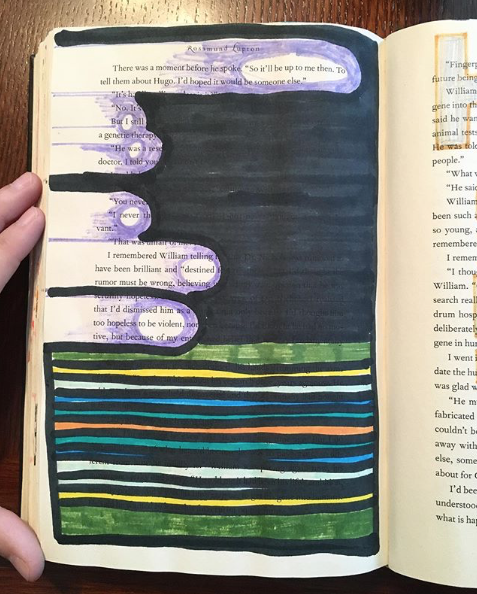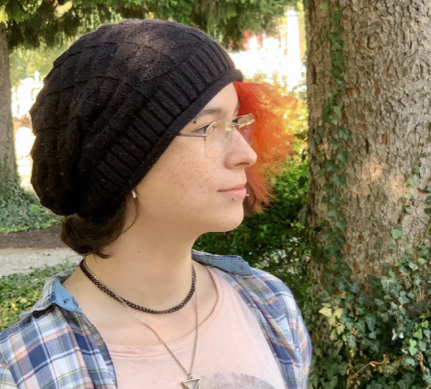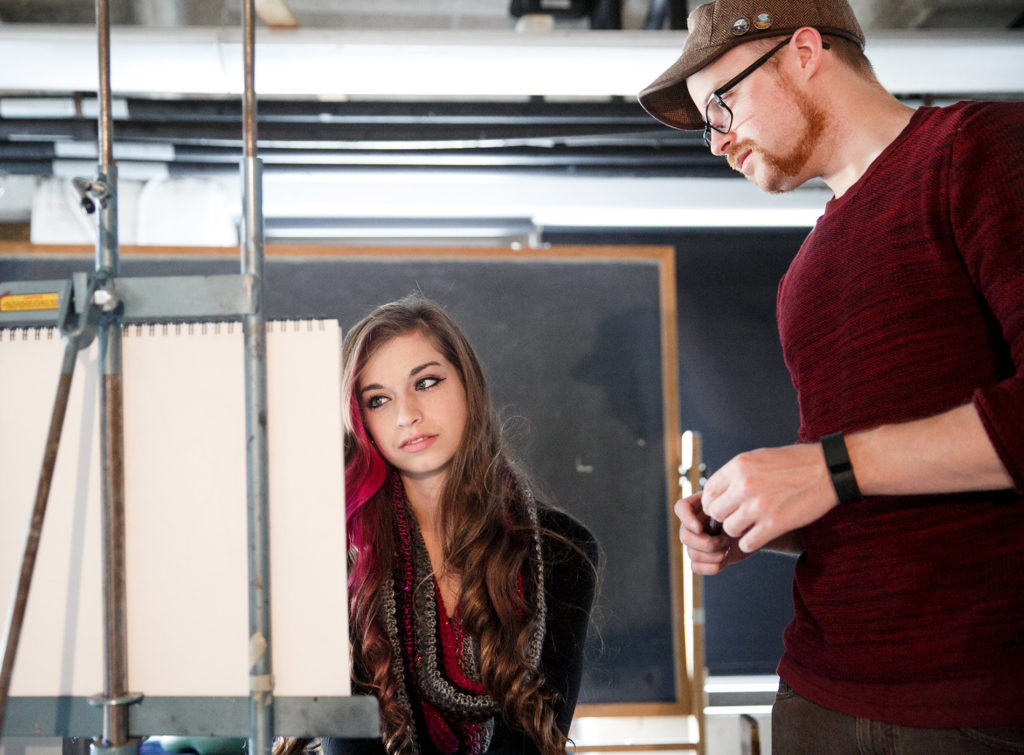
This fall, the Center for Creative Exploration dives into challenging the senses, the experimentation, and the thought process behind being creative
Wednesday, September 9th, 2020
At a time when everything seems to be reassessed and redesigned, three brand-new fall classes at PCA&D’s Center for Creative Exploration (CCE) are taking a different approach to art-making, too.
How can art engage and integrate multiple senses at the same time?
How can artists employ resources all around them to experiment with new, no-pressure, non-conforming ideas?
How can creatives gain an understanding of their thought process in ways that expand and push their own art-making?
CCE is exploring those ideas this fall with Matt Chapman’s Mindfulness Through Making, Ellie Cochran’s Digital Media Studio: Synaesthesia – Blending Senses, and Nichole Madonna’s Books as Art Objects: Erasure, Collage, and Altered Pages.
Here’s a quick, deeper dive into how these approaches to creativity can broaden the way students can approach their own projects and possibilities:
Mindfulness Through Making
The creative process has many paths that lead to being more in tune with how you’re feeling, or clearing a space for you to explore these feelings on a deeper level. Participants will engage in practices that focus on opening up a channel to understanding yourself though the act of creation.
Instructor Matt Chapman is a familiar presence at PCA&D. A member of the College’s Class of 2008 with a BFA in Illustration, Chapman went on to earn his MFA in Drawing and Painting from Pennsylvania Academy of the Fine Arts, and this semester also is teaching Drawing 1 in the College’s BFA program. How does he meld art and mindfulness? He’s been a student of martial arts for nearly 30 years — a practice that focuses heavily on meditation and personal wellness.
Tell us a little about the class
Chapman: Its focus is to make time for yourself. To explore paths to better understanding your problem-solving, thought patterns, and the aesthetics of your expression. It’s also a great way to create art that is free from a specific physical subject or source image.
What are you most excited about for this class?
Chapman: I’m really looking forward to introducing participants to the historical points of interest related to mindfulness and the act of making … and, of course, seeing how everyone translates to their work surface!
What are some of the most important takeaways that prospective students should know about your class?
Chapman: That you need to make time for yourself, whether it’s to make art, or to sort out your thoughts. When the two can converge it is a special thing and can really lead to great accomplishments.
You’re also co-owner of curio. Gallery & Creative Supply in downtown Lancaster, and a specialty painter for Two Dudes Painting Company … what do you do for fun when you’re not teaching/working?
Chapman: I make paintings and drawings, go for walks in the woods, play video games, and hunt for vinyl records.
Mindfulness Through Making: Wednesdays, 7-9 pm, Oct. 7-28, online.
Books as Art Objects: Erasure, Collage, and Altered Pages

So it’ll be up to me then. I was never destined to be violent. — Nichole Madonna, via Instagram @nikkymadonna.
Think of an old book as a repurposed canvas, each page a new prompt. What do the patterns on the page evoke? Is there a particular word or phrase that stands out? A specific chapter or page number that sparks an old memory? Using collage, mixed media, and erasure, students will transform an unused book into a one-of-a-kind art object. Taught by Nichole Madonna, who is showcasing her own Altered Book project, one page at a time, on her Instagram.
Nichole Madonna‘s approach to her own art folds seamlessly into the class she’s teaching this fall for CCE: “My art practice … (includes) aggressively carving out time and space for art,” she says, “using the resources all around me at home when I don’t have the time or money to spend on supplies, and realizing that material goods (and my art practice) should be ‘unprecious’ to my children.” A leader in Tinkergarten, Madonna also is a familiar presence at PCA&D, where she earned her BFA in 2010.
Tell us a little about your classes.
Madonna: Books as Art Objects creates a space for those with restless hands who want to be creative, without the pressure of conforming to orthodox standards of Fine Art. We will make an art object that you can carry anywhere, hold in your hands, and (that) uses up leftover materials that you already have on hand — leftover paint on the palette, scrap paper bits, found words and poetry within the book, and various mark-making tools.
(Madonna also is teaching Endless Possibilities: Collage and Mixed Media for Grades 5-7: This class “uses the same principles, but the kids will create a few pieces of 2D art that they can take home at the end of the course. This tactile class encourages recycling materials like junk mail and magazines, experimentation, and using various methods, such as drawing, painting, and collage, in one piece of artwork.”)
What are you most excited about for Books as Art Objects?
Madonna: For participants to be able to intuitively continue this project outside of the classroom, and follow each other’s progress on social media. The Unprecious Book combines my loves of reading, paper, journaling, and keeping a sketchbook.
What are some of the most important takeaways that prospective students should know about your class?
Madonna: Books as Art Objects is a course for ANYONE. Everyone is an “artist” when they make something, and this project only takes intuition and restless hands. Art is cathartic and healing.
What initially compelled you to start this project on your own?
Madonna: Finding myself stuck at home with my children during quarantine, needing an unthinking creative outlet, while also not having access to many Fine Art materials. It is a very cathartic project.
What do you do for fun when you’re not teaching/working?
Madonna: I spend most days with my kids, hiking and spending time in nature, and creating non-digital art with various materials.
Books as Art Objects: Erasure, Collage, and Altered Pages: Wednesday, Oct. 8, 6-9 pm, in person.
Madonna is also teaching an in-person class for Young Artists (Grades 5-7), starting 9/26: Endless Possibilities: Collage & Mixed Media
Digital Media Studio: Synesthesia – Blending Senses
In this exploration of synesthesia (the cooperation of multiple senses to enhance the experience of an art piece, performance, technology, or design), students will learn the characteristics of synesthetic media, and will create a digital media piece which elegantly integrates two or more senses to create a synesthetic association in their audience.
Like Chapman and Madonna, Cochran, too, is teaching a class that feeds into her own personal art-making. “I’ve been interested in multimedia and computer art as long as I can remember,” Cochran says, “and created an augmented reality music visualizer as part of my thesis” when graduating from PCA&D in 2019 with a BFA in Graphic Design. Recently, she says, he has been focused on “creating virtual-reality experiences, especially ones timed to music … This exploration of engaging viewers on multiple sensory levels motivated me to create this course.”
What do you do professionally?
Cochran: I’m the Design Director for the Lancaster LGBTQ+ Coalition, and I run and independent design company called Ellie LLC.

Ellie Cochran, instructor for CCE’s “Digital Media Studio: Synesthesia — Blending Senses” this fall.
Tell us about what you’re teaching this fall.
Cochran: Digital Media Studio: Synesthesia — Blending Senses is an investigative course in which we will discuss how various pieces of art and media integrate multiple senses to create a gestalt experience.
(Cochran also is teaching Intro to JavaScript: “a technical course which covers the fundamentals of object-oriented programming and the syntax and semantics of the web programming language JavaScript.”)
Were you born with synesthesia?
Cochran: Aside from my interest in art, I’m also a musician and have been practicing and performing various instruments for most of my life. While I don’t have neurological synesthesia, this background in both fields lends itself to creating and analyzing work which engages the viewer on multiple sensory levels.
What are you most excited about for this class?
Cochran: I’m most interested in investigating how the principles of synesthesia in art can be applied to enhance user experience and accessibility of technology, such as through the use of audio and haptic feedback to enhance or provide an accessible alternative to an animation or visual cue.
What are some of the most important takeaways that prospective students should know about your class?
Cochran: As organisms, we rarely interact with the external world through only a single sense. The experience of eating an apple appeals to us not only because of the taste, but also because of the sound of the crunch as we bite through, the smell of the juice, the sensation of our teeth breaking through the skin, and the appetizing sight of the shiny red exterior. I believe that as artists, we can more effectively communicate meaning by engaging multiple senses synergistically in our work.
What do you do for fun when you’re not teaching/working?
Cochran: I’m an avid guitar player and I love rhythm games!
Digital Media Studio: Synesthesia – Blending Senses: Tuesdays and Fridays, 6 pm, Oct. 6-30, online.
Cochran is also teaching an Adult Professional web design class, starting 10/5: Introduction to Javascript

